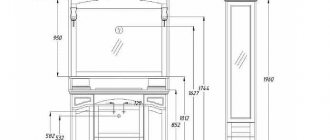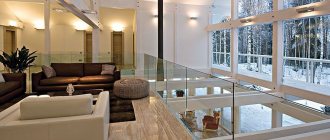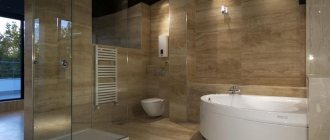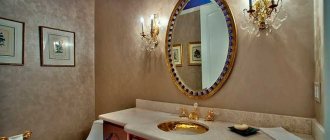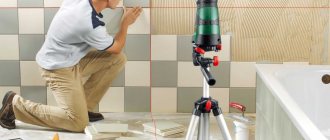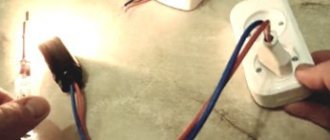Electrician in the house
Encyclopedia about electricity from A to Z
Masters catalog
Find the best master or company in your city
Choosing lighting for the bathroom
At the moment, bathroom lighting options are quite widely presented on the Internet. But unfortunately, not all of them meet not only lighting standards, but also basic safety requirements.
Therefore, if you set yourself the goal of creating not only beautiful and functional, but also economical and safe bathroom lighting, then our article is for you.
- Requirements for the electrical network of the bathroom Lighting standards in the bathroom
- Standards for the location of electrical equipment in the bathroom
- Standards for arranging the electrical network of a bathroom
What not to do
There are prohibitions for the entire premises and for its individual zones.
Restrictions according to GOSTs and SNiPs
Prohibited activities are listed in local regulations. These lists may differ in different regions, but basically they are the same. For Moscow, Resolution No. 508 PP applies. According to this document, it is prohibited to lay grooves in reinforced concrete slabs and interpanel joints.
Channels can be laid in the finishing or under a suspended ceiling or plasterboard sheathing of a metal frame.
Some restrictions are introduced by GOSTs and SNiPs. Technical standards prohibit open wiring. You can only use a triple wire with a phase, neutral and protective conductor. Each of them must be in its own protective shell. All three wires are connected together under an additional layer of insulation.
The use of metal coating without insulation is not permitted.
For laying, corrugated or plastic pipes should be used. Metal ones cannot be used. If the cable is damaged, such a coating will not be able to protect against electric shock. The use of electrical tape is not permitted.
There is no need to skimp on communications. It is better to take a thicker section so that the core does not burn out under intense loads. Typically, an aluminum cable with a cross-section of 4 mm2 or a copper cable with a cross-section of 2.5 mm2 is used. You cannot combine copper and aluminum - this will lead to a reaction between them.
It is prohibited to place switches, electrical panels and distribution boxes in the bathroom.
Sockets and all devices must have a residual current device (RCD). There are special models for wet rooms. All equipment must be grounded. To minimize the risk, even a bathtub can be grounded if it is made of steel or cast iron.
Under no circumstances should you do grounding yourself by connecting a wire to a heating radiator or water pipe. This can be dangerous to life and health.
According to the Civil Code of the Russian Federation, any changes that require inclusion in the technical passport and the BTI plan require the creation of design documentation.
Only an engineering organization with SRO approval can draw up a project. Documentation must be approved by government authorities. The installation of lighting, as a rule, cannot be classified as a refurbishment, but it may be part of a plan that requires a number of changes to be made to the layout and energy supply of the apartment.
To avoid mistakes, everything must be carefully planned and calculated before starting work. To avoid getting an electric shock, you should work with the electricity turned off.
Restrictions for individual zones
Lighting in a small bathroom, as well as in a spacious room, depends on areas with different degrees of humidity.
Four sections can be distinguished:
- The space above the bathtub, as well as inside the shower stall, where there is especially a lot of water and steam, and the humidity concentration is the highest. Here you can install lamps with a power of up to 12 W with a protection index of IP 674 or more. This parameter is always indicated on the packaging or in the instructions. The first number indicates the degree of protection against dirt. It ranges from 1 to 6. The second shows how well the product is protected from water and steam. The maximum value is 8. At this level, it can be immersed in liquid for a long time. The last number is impact resistance. It ranges from 0 to 10.
- The space adjacent to the sink and shower stall and other plumbing fixtures. Drops of water may reach here. You can use lamps with a power of up to 24 W and a degree of protection IP 452.
- An area located at a distance of 50 cm from the sink and other appliances. There are no power restrictions here anymore. The index must be at least IP 242.
- The last section is everything that comes next. Drops usually don't reach here. Moisture enters here in the form of steam and condensate. Devices with an IP rating of 011 and higher are used in this area.
This zoning applies regardless of the presence of a hood. It is suitable for separate and combined bathrooms.
How to install lamps correctly
Installation of spotlights
There are two main points on which the installation feature depends: the type of lighting fixture and the installation location.
- On the main ceiling. To provide central lighting, spherical shades and lamp plates are used. If the ceiling surface is made of concrete, hardware or dowels are used for installation; if the ceiling surface is made of wood, self-tapping screws are used.
- Plasterboard suspended ceiling. In most cases, spotlights are installed here. Wiring is pre-planned. The installation process itself consists of a number of actions: mandatory switching off the voltage, connecting the lamp to the cable terminals, inserting the lamp into the housing and screwing in the light bulb.
The last option is a suspended ceiling. The installation process here is very complicated, since the stretched fabric is very easily damaged. To avoid unpleasant moments, you should remember:
- careful design of lamp markings before installation;
- mandatory cable insulation;
- formation of embedded platforms or hooks for all lamps.
For stretch ceilings, it is recommended to use fluorescent or LED lamps. The devices do not heat up and do not cause damage to the canvas.
How many lamps will be needed?
The number of lighting fixtures in the bathroom depends directly on its area. If the room is very tiny, and its area is about 5 m2, then a chandelier in the center of the ceiling with two or three lamps will be enough.
But even if the bathroom is small, it is better to additionally illuminate the washbasin and mirror area to make all cosmetic procedures much easier.
If the bathroom is spacious enough, then it is necessary to provide zone lighting, the features of which will depend on the configuration of the room, design ideas and some other factors.
It is important to consider a lot of other factors that affect the lighting in the bathroom. These include:
- interior style, or rather the chosen color scheme, because, as you know, light shades reflect light fluxes more, which means the room will seem more illuminated. The same can be said about glossy, mirror and glass surfaces;
- the height at which the lamps will be installed, because the closer they are to a person, the brighter the light they give;
- type of lamps.
It is better to decide on the number and location of lighting fixtures at the stage of repair work in order to avoid unnecessary hassle and waste in the future.
Useful video and tips
Thus, the light for the bathroom directly depends on the materials of the walls and ceilings. Overhead models are more suitable for concrete; built-in models are more suitable for suspended ceilings. Depending on the size of the room, the size of the lamp is selected: the smaller the bathroom, the smaller the number needed and the smaller the light sources should be.
Even for a small room, it is recommended to use a ceiling light and highlight the mirror. It is better to use natural shades of light bulbs to really evaluate your appearance. If there is a window, then make the most of natural light.
- Related Posts
- Decorative neon lamp 220 V: principle of operation, characteristics, how to connect
- DRL lamp 125,250,400,700 decoding and technical characteristics
- The first light bulb
What type of lamp should I choose?
Today, the choice of lighting devices is so extensive that everyone can choose the option that best suits their wishes. So, according to the type of location on the surface, lamps can be:
- open;
- built- in This option is preferable for miniature bathrooms with not very high ceilings.
Depending on the location, the lamps can be:
- ceiling _ This is a timeless classic. Each bathroom should be equipped with at least one ceiling lamp, which will be responsible for the general light in the room;
- wall- mounted These are lamps that are designed to highlight certain functional areas of the room;
- floor lamps perform more of a decorative function; they can add zest to the interior of a room and visually expand the space of the room.
Each of the lamps used can perform one or several of the following functions:
- work lighting;
- decorative lighting;
- directional lighting;
- general lighting.
, different types of lamps can be used as light sources
- incandescent lamps;
- halogen;
- luminescent;
- LED
Everyone has the right to choose the type of lamps themselves, depending on the type of lamp or their own desire to save money, but special attention should be paid to LED lamps. They are considered the most economical and safe, because they do not heat up during operation. LED strip is also often used, which adds a real zest to the bathroom interior.
The only drawback of LED lamps is their high price.
The most expensive bathrooms
Unfortunately, it was not possible to find the exact cost of expensive rooms (with one exception). However, the following are considered the most expensive bathrooms.
Shangri-La Hotel (Istanbul). There is a TV built into the mirror.
7-star Burj Al Arab hotel.
Parisian castle Chateau Louis XIV.
Room with a window at the Ritz-Carlton Hong Kong (China).
A mansion in California boasts a $9.9 million bath.
If we take an indispensable attribute of any room - the bathroom itself - then they are also made from a variety of expensive materials.
Fossilized Indonesian wood over 180 million years old.
Made in a single copy. Price: $1,740,000. It belongs to a certain billionaire from the United Arab Emirates.
The billionaire does not advertise his name, and rightly so. After all, the owner of another expensive gold bathtub lost it. The gold container was simply stolen from the Japanese Kominato Hotel. And it cost $990,000 and weighed 86 kg.
Golden bath
The original rock crystal font is the heaviest. It was made in three copies. Two of them were sold: to a Russian oligarch and an Italian socialite. The cost of the plumbing was $790,310. The third copy is still for sale.
Crystal Font
Relatively inexpensive, but very beautiful bathtubs are made of amethyst and malachite. They cost $122,000 and $222,000 respectively. They also have legs made of gold.
Selecting the appropriate lighting power
Of course, there are engineering laws, formulas for calculating illumination with several variables and exact results. But in practice, the lighting intensity is rather selected by eye, based on the principles of “like-dislike”, “already annoying or still quite tolerable”.
The number of mirror and reflective (glossy) surfaces plays an important role: they visually increase illumination.
If there are many light sources, you can consult with a designer, a technical specialist, or simply on an Internet forum.
It is important to take into account sources of natural light: windows in bathrooms are not uncommon in dachas and cottages, and in city apartments there are transparent windows under the ceiling. During the daytime, they allow you to save electricity - use the bathroom without turning on the lights.
Optimal lamp type
When organizing lighting for a bathroom or toilet, you need to take into account the characteristics, pros and cons of different types of light bulbs.
There are the following types of lighting elements:
- Incandescent lamps are the most affordable light sources. However, their service life is no more than 1000 hours. They emit bright light, but heat up quickly, so they cannot be used for closed, plastic or textile shades.
- Halogen - their luminous efficiency is high, they last a long time. However, it is recommended to use them for lamps with a special metal diffuser. For lamps with a voltage of 12 V, a special step-down transformer is required, which is quite expensive.
- Luminescent - have a wide range of colors, they can emit daylight, warm or cold light. However, at low voltage they begin to glow dimly or turn off completely. In addition, their bulb is filled with mercury vapor, which is dangerous if the bulb breaks.
- An LED lamp is the best light source of all. They last about 50,000 hours, consume a minimal amount of electricity, have a wide spectrum of light, and emit a soft but bright light. Their only disadvantage is the high cost and the need to connect a power supply and dimmer. However, this disadvantage is compensated over time by saving energy.
Choosing suitable lamps - what you need to know
The number of lamps in the bathroom depends on the area. But even in the smallest bathroom, the minimum is two light sources on opposite walls. There is no maximum, since you can easily highlight:
- mirror on the sides;
- the lower part of the furniture and the bath itself;
- niche perimeter; a distant shelf or hanger.
A medium-sized bathroom will benefit if several lamps can be switched on in different orders, for example:
- for shower only;
- for cosmetic procedures;
- for preparation for and during washing;
- for meditation while lying in the bathroom (moderate, white or colored lighting is suitable).
The best options for bathroom fixtures
To choose a suitable lamp, you need to decide what area it will illuminate. If the light is distributed throughout the room, it is better to choose a device with bright diffused light - a pendant or overhead product.
For a room designed in a minimalist style, built-in point light sources are suitable. Near the bathtub, sconces, floor lamps, lamps with adjustable beam direction, and pendants are installed.
When choosing a lamp for the bathroom, you should consider the following rules:
1. Experiments with a lampshade decorated with a pattern may end in failure. A matte light and monochromatic lampshade is the best solution.
2. It’s good if the device has maximum color rendering. Looking in the bathroom mirror with such lighting is a real pleasure.
3. It wouldn’t hurt to adjust the brightness of the product, adaptable to different application tasks.
How to properly position light sources in the bathroom
Must be avoided:
- Bright blinding glare.
- Distortions of reflection in the mirror, including colored spots.
- Shadows falling on objects and areas that are frequently used.
Lamps and lampshades tend to heat up. Make sure that children cannot reach them to avoid burns.
Furniture lighting
Furniture, large pieces of equipment, niches and built-in cabinets are illuminated along the perimeter, as well as along the edge of open shelves.
If necessary, highlight objects attached to the wall (hanger, heated towel rail).
The installation sites for water meters must be clearly visible with primary or additional lighting.
Consider the characteristics of family members and their health. Someone has poor eyesight, which means you need to try to highlight with bright color or lighting: a hanger, a socket, a place for the remote control.
All protruding edges and edges should be clearly visible, and lighting will play a decisive role in this.
Floor and ceiling lighting
Floor lamps with color-changing lighting are very beautiful. They, as well as spotlights at a level of 5-15 cm above the floor, bring some mystery, hint at large pools, the sea and its secrets.
True, you need specialist advice to determine how advisable it is to place the lighting at floor level (or even lower) in this particular house or apartment.
If you have the slightest doubt about the safety of such a project, it is better to consider other options.
The design of the ceiling is directly related to the possibility of placing lighting fixtures. Single-color stretch ceilings, welded stretch ceilings and two-level ceilings provide many unusual effects that can be achieved with the help of lighting.
General recommendations
The bathroom needs bright light
Good, bright background lighting is recommended for bathrooms. The minimum standard illumination according to SNiP and SanPiN is 300 lux.
Remember that the light level is affected by the color, material of the walls, floor and ceiling. Dark, rough surfaces absorb light, while smooth, light surfaces reflect. Moreover, reflected light from the walls and ceiling visually enlarges the space.
For bathrooms, especially large ones, it is important to illuminate the functional areas separately from each other.
Soft diffused lighting of shelves, bedside tables, and cabinets will add additional comfort and make it easier to find the things you need.
The size and design of the lamps must match the size and design of the interior.
Decorative lighting
She may be:
in form and structure:
- point;
- linear;
- scattered - semi-hidden, for example, by the edge of a two-level ceiling.
by color:
- colored plain;
- changing color;
- with flickering and “winking” modes, like in New Year’s garlands.
The best-designed lighting system will not work fully if ventilation does not function well enough, if water vapor and dampness accumulate and remain for a long time.
Mirror and washbasin lighting
Depends on the overall style and design of the bathroom:
- Figured lamps on both sides of the mirror.
- Illumination around the perimeter, including the edges of the shelves and the lower border of the sink.
- Sometimes a large wall lamp in the center above the mirror and sink is enough.
Tinted, matte lampshades and the use of energy-saving lamps are recommended. The easiest way to select the lighting intensity is by experiment.
If anyone in the family uses contact lenses, good mirror lighting is vital. In this case, it can be considered mandatory to install two symmetrical lamps to the right and left of the mirror.
It is advisable to allocate a separate shelf or niche for a container with lenses and lens care products.
Illumination of mirrors, washbasin, other elements
The lighting of the mirror should be natural so that it does not distort the reflection. It is better to install the lamp above it, on the sides, or combine these 2 options. Choose lighting fixtures with white shades with a matte finish that emit soft light.
The LED strip can be installed under the sink or along the edges of the bathtub. Plates with diodes are used to illuminate niches, drawers with clothes, cabinets, or along the perimeter of the wall.
In the bathroom or shower, lamps help create a relaxing atmosphere. Several devices can be installed above the bathtub or in the shower stall.
It is not recommended to install the lamp under a mirror, otherwise the display will be distorted. For the same reason, you should not use colored light bulbs or lampshades.
Styles and types of lamps
by location area :
- Sconces are wall fixtures of various shapes. They are produced in classic, oriental and modern styles.
- Spot - look good in a small bathroom. They are usually installed on the ceiling, in niches, corners or along walls, in the shape of a square, circle, wave, etc.
- Ceiling - large chandeliers in various style variations. They should have several lamps. But in a small bathroom, such lighting will visually reduce the height of the walls.
Types of lamps:
The most common interior option is spotlighting in the bathroom. The main thing is to choose the right lamps.
LEDs and RGB strips are the newest development at the moment.
Their advantages include:
- the ability to use them in rooms with high humidity;
- variety of colors;
- this is the most energy-saving type of lamps - 60% more economical compared to alternatives;
- such lamps are environmentally friendly;
- service life declared by manufacturers is 10 years;
- many models are available with a control panel that changes the rhythm, color and intensity of the light.
Halogen lamps. They have the following properties:
- bright light;
- low energy saving;
- direct, non-diffused lighting;
- cheapness;
- strength;
- instability to overvoltage.
The scope of application of halogen lamps is diverse: automotive industry, interior, street lighting, household appliances. For this reason, they are easy to find on sale.
Incandescent lamps are the most common and versatile type of lighting and have been used in ceiling and wall fixtures for over 140 years.
Characteristics:
- resistance to temperature and voltage changes;
- minimum energy consumption;
- safety - a broken incandescent lamp does not emit mercury vapor, like some types of similar devices.
Let's summarize
Lighting is usually located on the ceiling (in more rare cases on the walls), but this is far from the only placement option. The lighting on the floor of the room will look quite unusual and interesting - it is designed rather to transmit diffused, slightly dimmed light, which will allow you to relax in the bathroom after a hard day.
The bath itself can also serve as a source of light, along the perimeter of which a chain of light lights is built. This kind of lighting is intended precisely as additional lighting, which can be used for relaxation by turning off the main source.
If you have only one lamp, you won’t be able to change modes - what you have is what you have to use. Multiple lighting leaves the opportunity to choose according to the mood.
A very important area of the bathroom that needs to be illuminated especially brightly is the sink with a mirror above it. This is where we perform a lot of hygiene procedures, and we need to see our face clearly.
The lighting can be installed on the sides of the mirror, under it or above it. There are models of mirrors with already built-in lighting, and for ordinary ones you can purchase a separate lamp.
When choosing a lamp, pay attention to protecting its body from moisture: splashes can fall on the lamp at any time, especially when it is placed directly next to the sink and bathtub.
Often, instead of a mirror, an entire wall cabinet is purchased at once: the mirror doors, in which you can see your reflection, dissolve, and everything you need for washing, as well as cosmetic supplies, is stored inside. This “combined” option is quite convenient: it saves space, and the necessary items are always at hand.
Sometimes the shelves are located not inside the mirror, but on the side of it.
Most companies have thought out the issue of lighting this kind of items very well: LEDs are installed in the cabinet, directly on top, or along the perimeter of the shelves, providing an even light that does not hit the eyes.
If the bathroom cabinets are located separately, then you will have to think through the lighting for the shelves yourself. And it seems to me that it is necessary here. Often it is in such cabinets that huge reserves of all kinds of funds are stored, and no one wants to delve into the dark depths.
In addition to classic spot lighting, there are more elegant options - for example, transparent balls hanging from the ceiling give the room volume and look very gentle. But to install them you need fairly high ceilings, which not every home has.
The English style, which we wrote about earlier, goes even further and suggests hanging a luxurious crystal chandelier in the bathroom and placing sconces in the same style on the walls. The idea is quite controversial from a practical point of view, but it looks very nice.
Photos: homebuilding.co.uk, www.pinterest.com, happymodern.ru, ihouzz.ru, meekfamily.net, lwww.thayray.com.
Installation
The material of the ceiling covering in most cases becomes the determining criterion for choosing a lamp. If there is no overlay trim and the ceiling is a painted concrete slab, an overlay model in the form of a plate with a matte shade is best suited.
The lighting in a small bathroom will be quite intense if the lighting device is designed for two LED bulbs with a power of 7 W each.
It is installed as follows:
- Using a drill or hammer drill, holes are made in the concrete for self-tapping screws.
- The metal base of the lamp is applied to them and screwed to the base with self-tapping screws.
- The electricity in the house is completely switched off using an automatic machine.
- The electrical wire is connected to the lampshade.
- Light bulbs are screwed in.
- The lampshade snaps into place.
- The electricity is turned on and the operation of the device is checked.
- It will be more difficult to attach lighting equipment to a plasterboard base.
- If multi-level light is installed in the bathroom, the design of the room will only benefit from this. But realizing such an idea is not so easy.
First, a lighting design plan is drawn up, then according to it, the location of the light bulbs is marked. Double-insulated wires are led to it; they are laid along a metal profile, with the help of which a frame is formed for installing drywall.
The wires are secured with ties. Before installation, holes are drilled on a sheet of plasterboard for ceiling lights of the required diameter. After attaching the sheet, wires are threaded through them, which are then stripped and connected to the terminals of the lampshade. At the final stage, a light bulb is inserted into the lamp.
The lighting of the toilet is done in the same way if plasterboard is used as a ceiling finish.
It is even more difficult to install lamps on a stretch ceiling film. Carrying out such a procedure requires professional skills and the ability to make accurate calculations.
Without going into details, the installation of lighting equipment is carried out as follows:
- First, the frame of the lighting fixture is attached to the concrete base.
- Then the suspended ceiling is installed.
- Afterwards, holes are formed in the film.
- It is connected to the frame of the device using special insulating rings (they prevent possible rupture of the film).
- At the final stage, the light bulbs are inserted into the frame.
Note! To ensure that the canvas lasts longer and does not turn yellow when heated by lighting fixtures, you need to choose LEDs with a base for lighting the bathroom.
They do not heat up, which means that the film next to them will not lose its physical properties.
Top or ceiling level lighting
In small bathrooms, they usually make do with one lamp. It is quite enough for lighting. And if the room is larger, then it is better to install several pieces to distribute the light evenly. One is above the bathtub and the other is by the door.
Using small lamps with halogen lamps, you can create multi-position lighting (“starry sky”).
Lighting fixtures can be of different shapes: round or oval. It is important that they complement the design of the room.
Medium or working light level
The most important thing about medium lighting levels is to highlight important work areas. Usually this is a washbasin and a mirror. Install two lamps symmetrically on both sides at the top of the mirror. If it is small, then choose smaller lamps too.
This will create bright lighting that will not dazzle your eyes or create unnecessary shadows. It is important that the lighting devices are not reflected in the mirror, then your face will be clearly visible.
A great idea for a bathroom is lighting around the perimeter of the mirror. Strip LEDs, which are especially popular now, are suitable for these purposes. It is not advisable to install colored lampshades in this area.
If you have enough space for furniture in your bathroom, you can use lighting for it.
Build small light bulbs into doors, cabinets, and countertops. This will create the necessary accents in the room, elegance and a romantic mood.
Nowadays it is fashionable to illuminate the bathtub. It creates the necessary relaxing mood. But this option is not cheap and not everyone can afford it.
Don't be upset if you can't afford it. To create a more private atmosphere, sconces are also suitable. Choose one with a colored glass lampshade. Install it on the side of the bathtub, but not above it, for safety reasons.
- For a spacious bathroom, but with a slightly high ceiling, you can install a high floor lamp. This way the light will fall beautifully on the water.
- Swivel lights are also very good for mid-zone lighting. You can adjust the direction of the light yourself, where it is convenient for you.
Floor level lighting
Floor lighting is optional but not required. Its use creates a special magical atmosphere.
If you still decide to use it, then choose closed floor portholes (flashlights). Translucent lamps are also suitable for these purposes. Alternatively, you can use aromatherapy candles.
Do you need ceiling lighting?
Overhead lighting may consist of one or more fixtures. In a small room you can install one lighting device in the shape of a plate, and for a large room a chandelier and several lamps are suitable.
When choosing lighting equipment, consider the material of the ceiling covering. Suspended chandeliers are suitable for concrete bases, and built-in models are suitable for plasterboard and PVC ceilings.
A spotlight that emits directional light is suitable for the bathroom. It makes it possible to adjust the direction of the light flow.
A crystal chandelier framed by a diode strip will look luxurious. You can also install one lamp in the middle of the ceiling, and use spotlights to highlight the hotel areas. If the room is small, then place built-in fixtures around the perimeter to get even lighting and visually make the ceiling higher.
Worth remembering
- Light and smooth walls (ceilings) do not absorb light as much as, for example, dark ones with a rough textured surface.
- Fans of mirrors need to remember: to avoid the effect of multiple reflections, do not place them opposite each other.
- Plan ahead for lighting before renovations to run the cable.
- Don't forget about safety measures. Make sure there are no exposed wiring. If sockets are installed, they should be located away from washbasins and bathtubs (with moisture protection). Don't forget about grounding. Do not use extension cords or tees.
- When leaving the bathroom, don't forget to turn off the light!
Comments:
Korban
There is no particular need for a “protected” bathroom tape. Firstly, the voltage supplied to it is only 12 volts, which is imperceptible even in the case of direct contact with a person, and secondly, the contacts in the tape are made of non-oxidizing metal, so the effect of moisture on them is negligible.
Stepanych
Korban, all this is true, but only when it comes to places without much exposure to moisture. For example, it is better to illuminate the mirror above the sink with a protected version of the tape, because... there is a high probability of splashes on unprotected contacts. And we are no longer talking about safety for humans, but about the fact that from such splashes (as well as from wiping these splashes) the tape becomes unusable within six months to a year.
Sverdlov
Good article, but I wouldn't rely on the strip as the main light source, even in the bathroom. It illuminates too weakly, and the flickering can hurt the eyes. Like lighting a mirror or cabinets - that’s it.
Leave a comment Cancel reply
Similar posts
Preparing and connecting an LED strip with your own hands. Video. Organizing LED lighting for a cottage or country house with your own hands Design, technical capabilities, and scope of application of the LED strip 3528 Connecting an LED strip without a power supply
